
It’s been a few years since I last talked about Race Ranger, the triathlon-focused tech company that puts sensors on bikes to help athletes and refs more precisely determine and avoid the draft zone (which isn’t legal in most long-course triathlon). The system has been slowly gaining traction in various races over the last two years, primarily in the professional athlete category, where real money and income is on the line. And this weekend, by far the most prominent race to date is going to occur: All pros at Ironman Florida are being equipped with Race Ranger.
Of course, as noted, this isn’t the first time the platform is being used in the pro field, or on the world scene. Just five weeks ago it was used at the World Triathlon Paratriathlon Champs in Pontevedra, Spain. And it’s also been used in numerous other long-course events, such as the PTO European Open this past spring. It was even used in Ironman New Zealand earlier this year, and Ironman 70.3 Geelong Australia in April. But in terms of visibility and pro scene prestige, Ironman Florida this year is a big one with a packed field. It’s also the first time Ironman Head Referee/Official Jimmy Riccitello will be seeing the system hands-on, or rather, from being on the back of a moto next to it.
So, with that historical explainer laid out, I figured I’d take a moment to dive into the tech a bit and how it works. Back a month ago I got the chance to try it out in-person, alongside my wife, dropping in and out of the draft zone to precisely show and get an understanding for the system.
Note that while an eventual end-goal (years) would be for every athlete to have this system in a race, the near-term goal is really focused on the pro scene, where money is on the line (and thus, dinner on a table). But technologically speaking, there’s no limit to the number of competitors in the system, or using it.
General Overview:
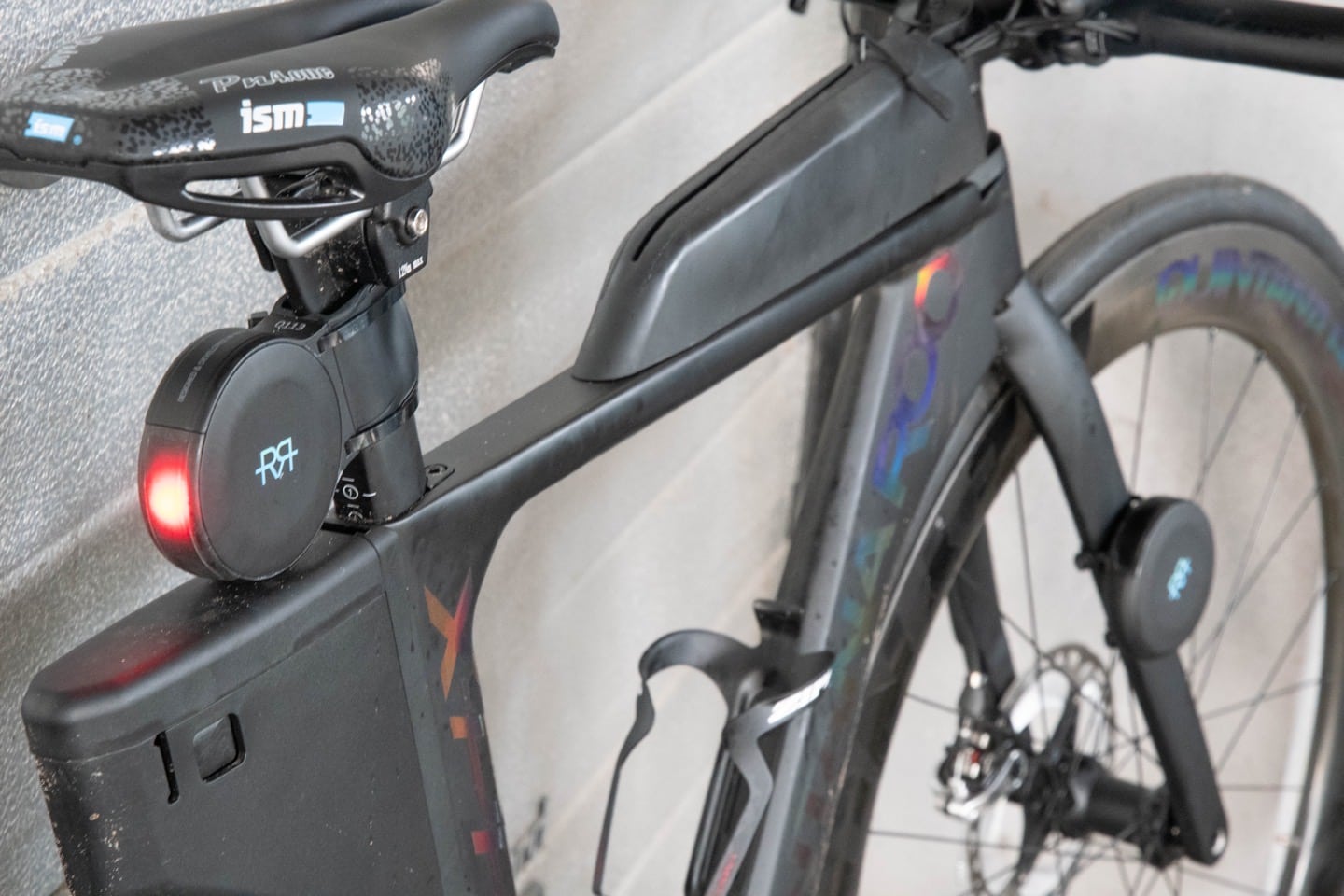
First a one-paragraph primer on drafting in triathlon. For virtually all long-course triathlon (basically, triathlon that has a bike component 56 miles or longer, such as an Ironman at 112 miles), these races are not draft legal. That means that you can only enter the draft zone of another cyclist in front of you for a brief period (usually 15-20 seconds, depending on the exact race specifics). If you fail to complete the pass in that timeframe, then you can receive a penalty if an official catches you. The draft zone will extend backwards usually 10-15 meters behind a cyclist. Again, the exact distance depends on the specific race. And finally, while attempting to complete the pass, if the athlete in front of you blocks your attempt, they can actually be cited instead. Note that once you ‘enter’ the draft zone, the *ONLY* way out is forward. You can’t dip into the zone, and exit again.
All of this matters because most people are not great at knowing exactly how far 15 meters is, relative to the person in front of them, while flying down the roadway. This can sometimes also extend to officials/refs. Back two months ago at the 2023 Ironman 70.3 World Championships in Finland, one professional athlete posted after the race pleading for the Race Ranger system after she received two draft penalties which she didn’t believe she was in the draft zone for. This is one of the rare scenarios where both pro athletes and race officials alike actually agree upon something: Using tech to make their jobs easier and more clear/fair.
Got all that? Good, let’s talk the tech details then.
The Race Ranger system is currently composed of two pods which affix via zip-ties to an athlete’s bike. These pods then communicate in a mesh network with each other, but also with tablets that officials/refs have, which track in real-time the separation between cyclists. Each of these pods is roughly the size of a medium donut, and has lights on it, which indicate various states (more on that in a second):
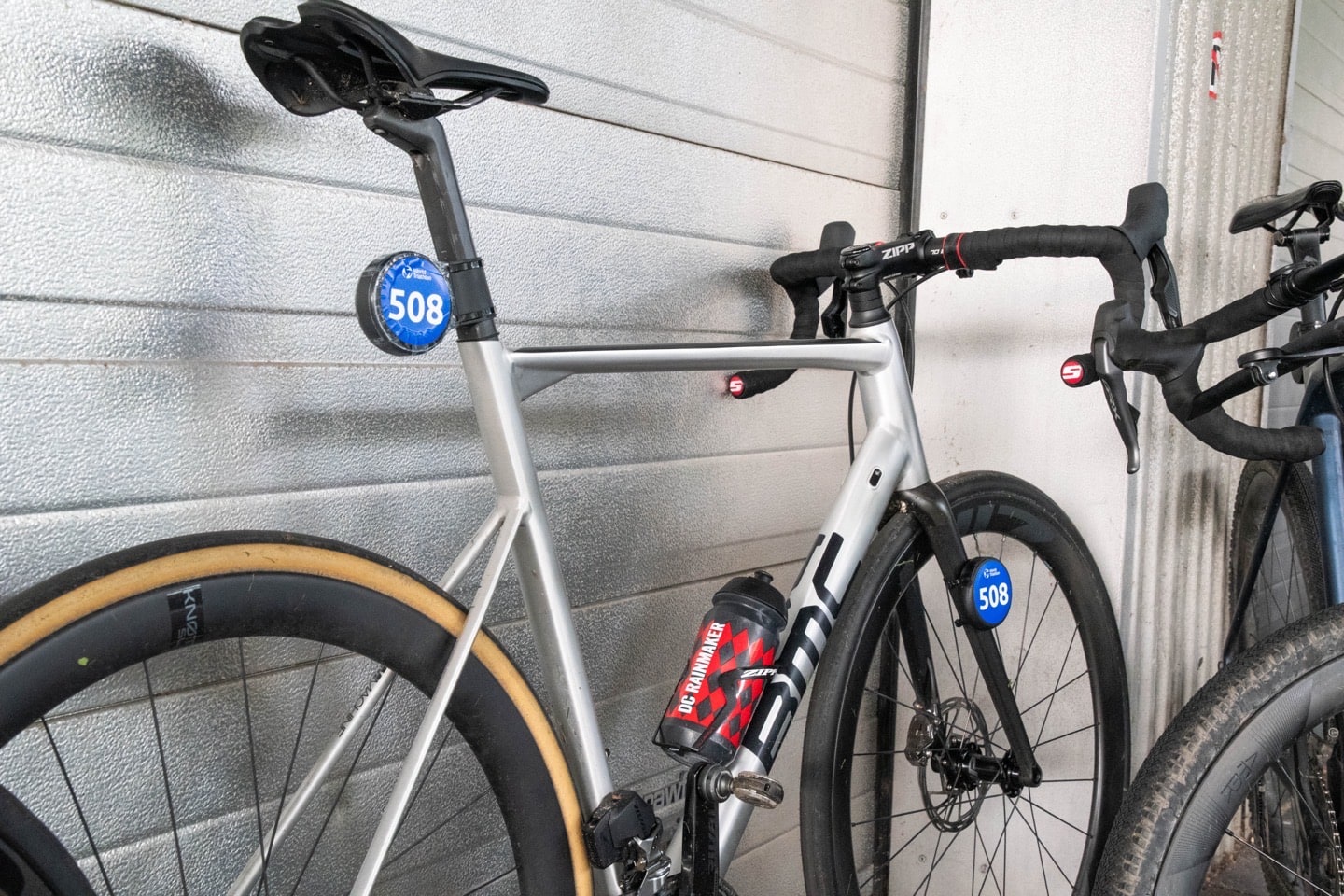
The stickers on the side are simply added/removed per race, and the system can be installed in mere seconds. I watched as the founder of Race Ranger, James Elvery, installed it quickly on both my bike and my wife’s bike. It took only a few seconds longer than a typical ref safety check of one’s bike that’s done during bike check-in to transition.
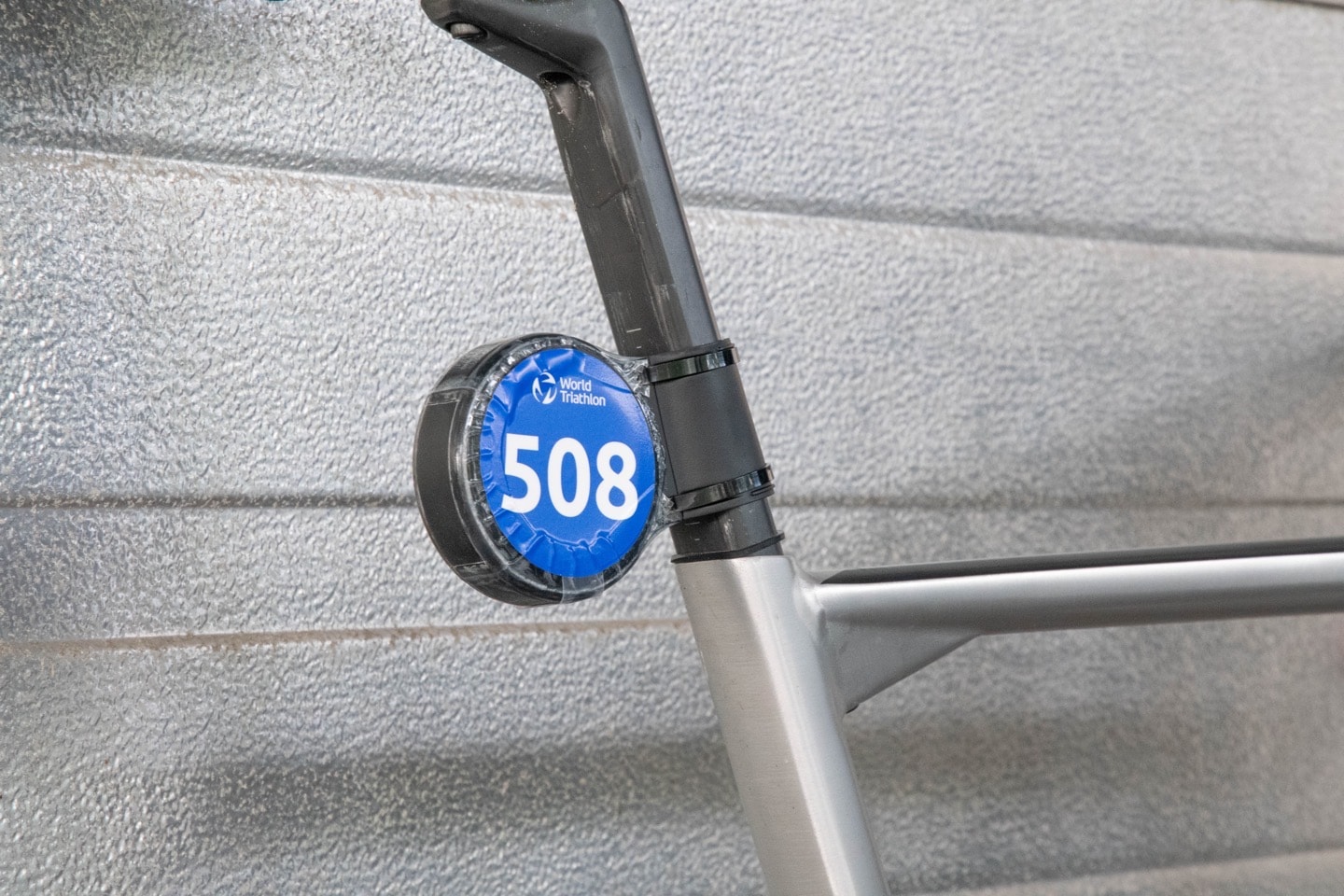
While some have raised concerns about the pod impacting the aerodynamics of a bike, one has to remember this is applied to all bikes equally. Certainly, each bike frame could impact aerodynamically slightly differently with the pod, but that’s true of other race-required components like race number stickers that flutter off the back of the seat post, which this would replace, as it has the race number on it.
These pods use WiFi, Bluetooth, GPS, and UltraWideBand signals, all blended together at different points, to pinpoint the exact location of a rider in relation to others. I’ll dive into that later.
Instead, the key thing to know is that the exact distances are configurable. In the scenario I was using it with, the pods had just come from World Triathlon Paratriathlon Champs in Pontevedra, Spain. And thus were set up for three specific warning triggers. First, was a trigger at 15 meters, then 12 meters, then 10 meters to began the draft zone. So, in essence, orange is saying “Yo, wake-up”, blue is telling you that you’re about to hit the draft zone, and red means you’re in the draft zone. Here you can first see the orange:
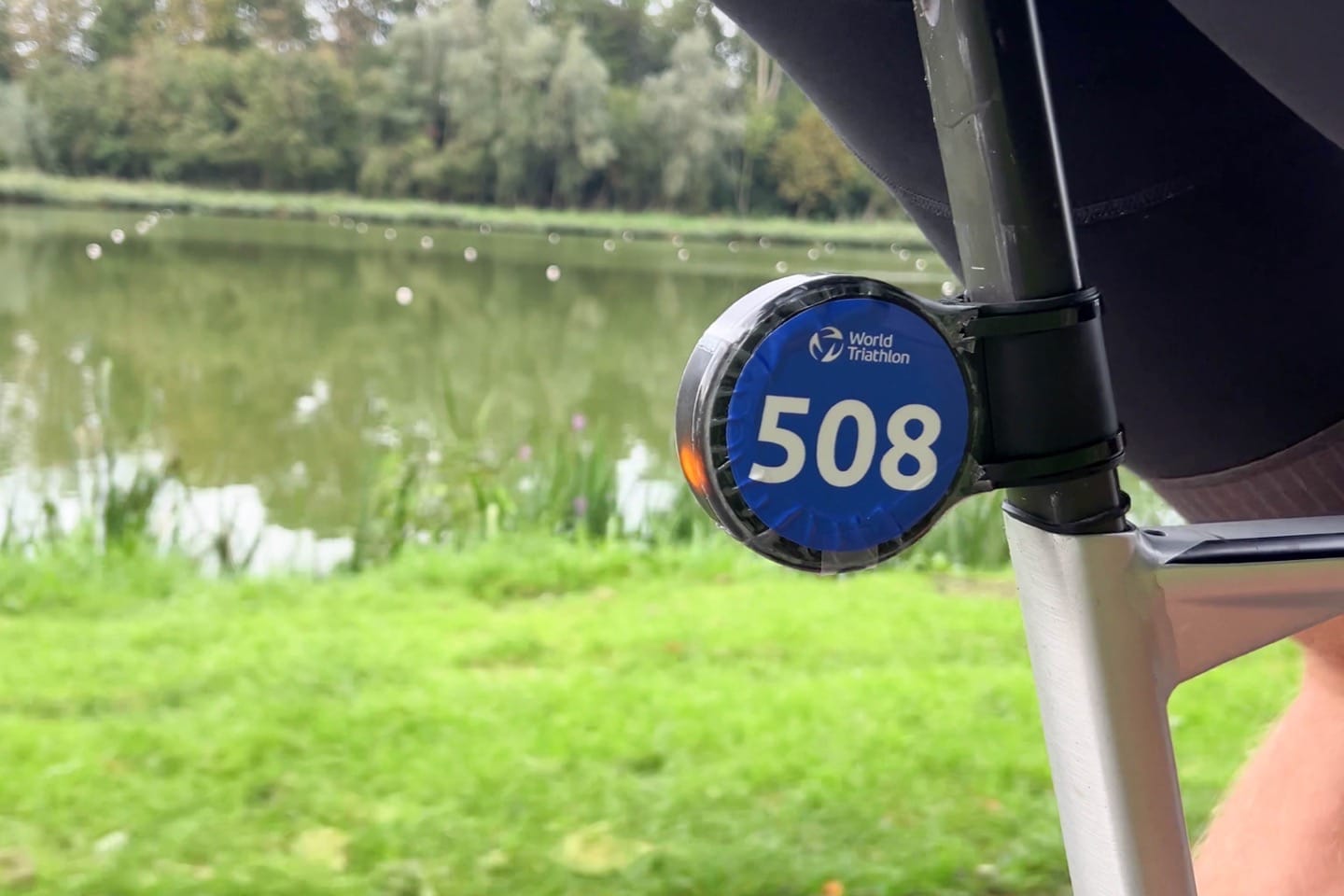
Then the blue:
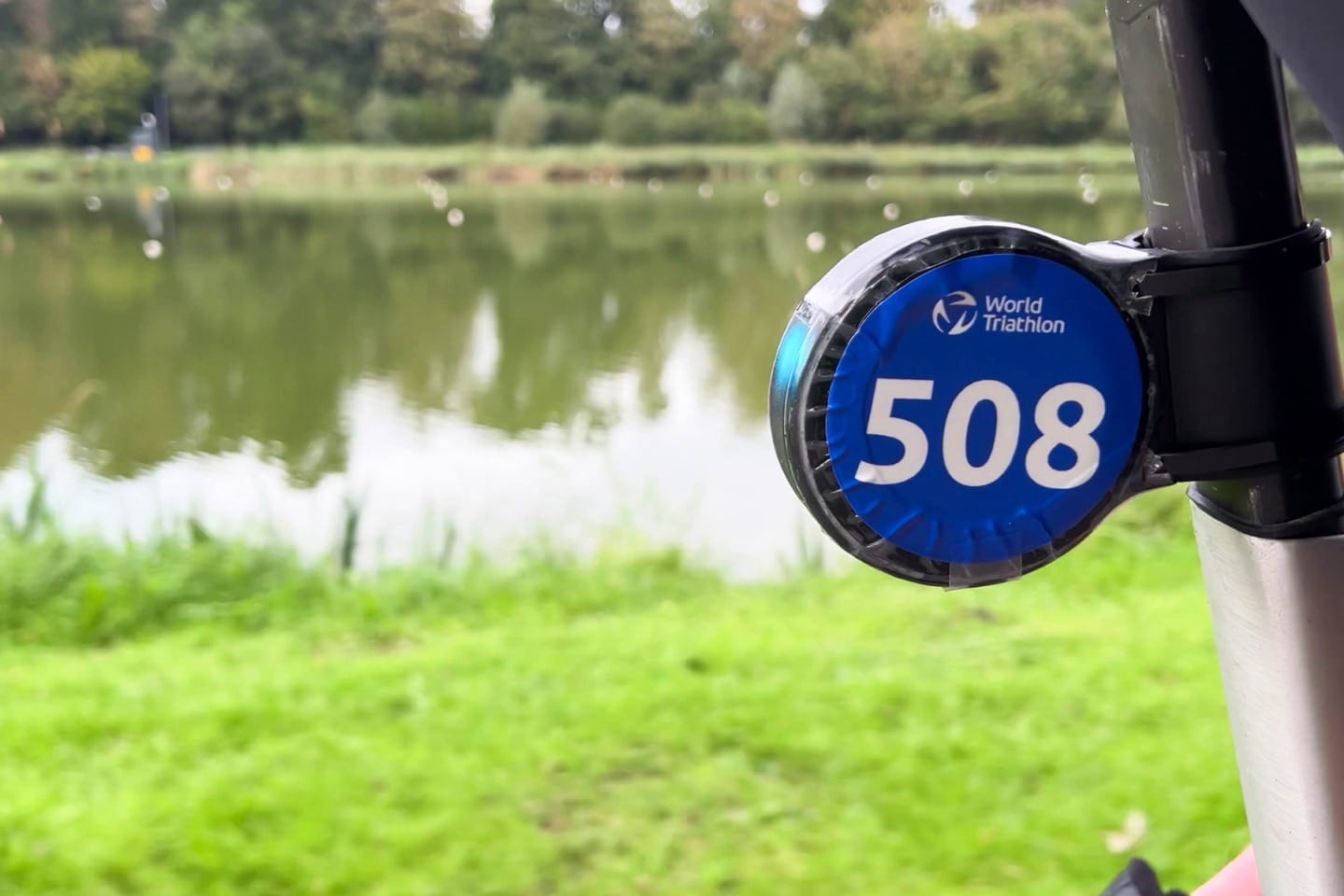
And finally red:
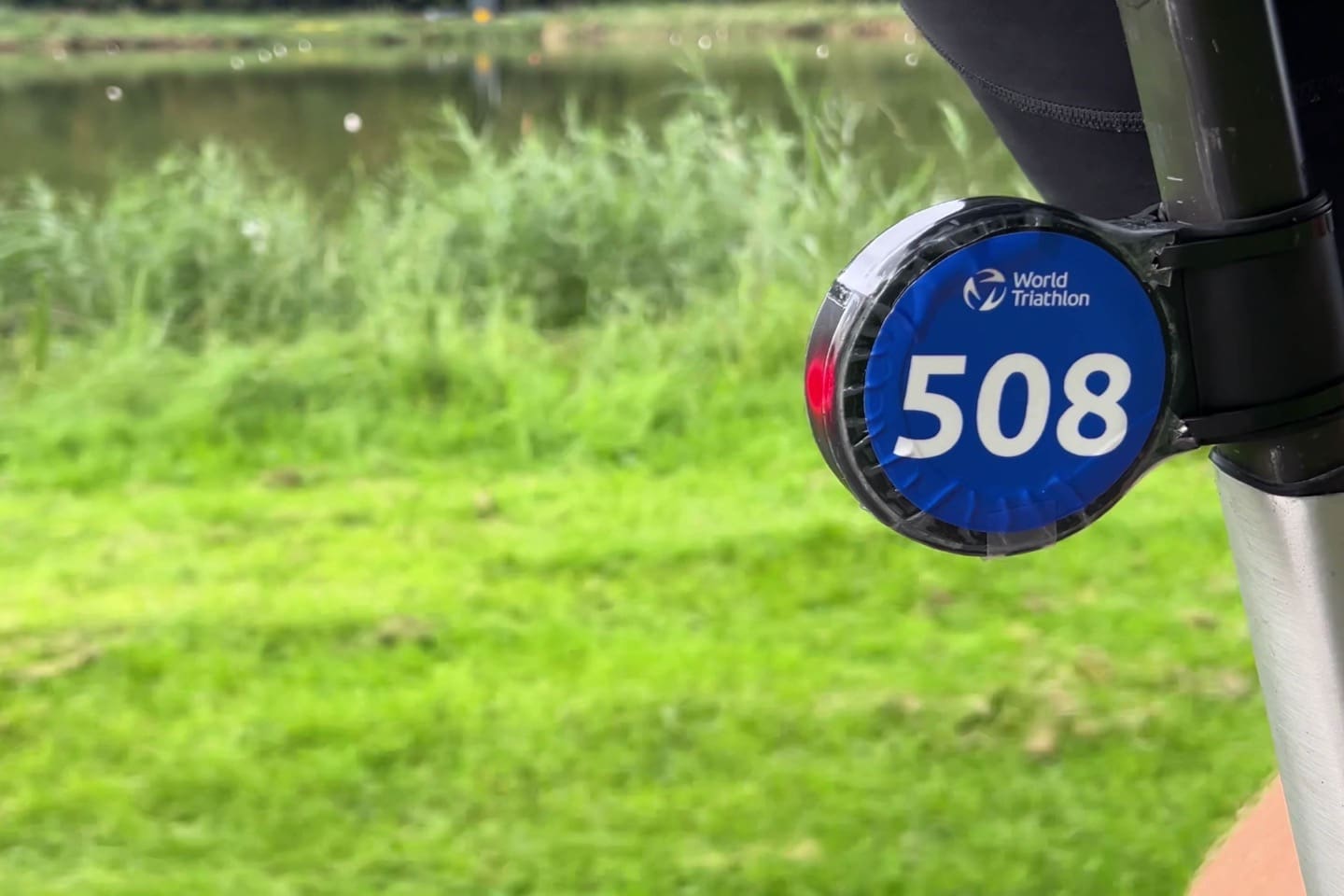
As you approach the cyclist in front of you, you’ll be looking at THEIR pod on the back of THEIR bike, not your own pods. This makes sense, as you’d be naturally looking ahead towards those bikes anyway. Here, you can see the coloring on the cyclist in front of me:

Watching a few passes (and doing a few myself), it’s impressively precise. Pretty much as soon as I get beyond the front wheel of the cyclist in front of me (passing them), it clears. It has similarities in execution from a user experience standpoint to Garmin’s Varia radar, except that you’d never really see the ‘all clear’ function, because it’s on the rear of the bike you just passed.
In the event that you are passing multiple people, you’ll see red on multiple bikes, and you’ll clear them individually. Note the red light on both bikes here. While this was a GoPro shot, the lights are super easy to see quite far away.
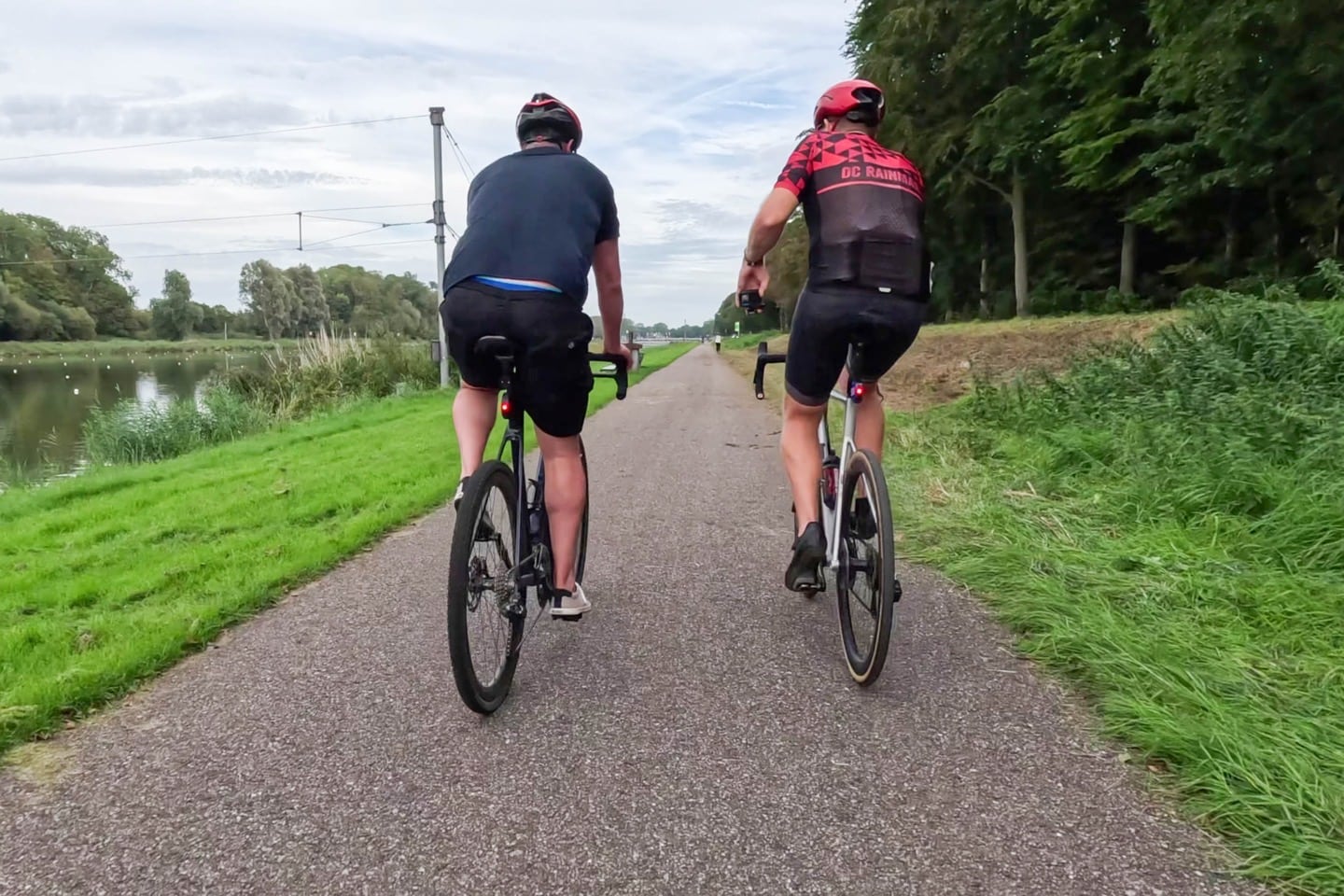
What’s cool about this is that everyone else can easily see these lights as well – most notably the officials on a moto. Thus, they don’t have to take out their imaginary tape measure, but rather, can simply look at the lights on the cyclist that’s being passed, alongside a timer. However, Race Ranger has gone a step further and has an entire tablet app that will show details on each athlete, including the passing time. Thus an official could see/track exactly how long each pass is taking, and do so either right next to the athlete, or from a distance.
The company claims a range of about 10KM – which is pretty darn far. Obviously, most refs are going to focus on athletes within likely just 30-50m.
And that’s a key thing to understand: At this point, no race organizer or governing body is asking for Race Ranger to go into fully autonomous mode and hand out penalties automatically. And honestly, it doesn’t seem like athletes want that either.
After all, there are numerous edge case scenarios where race organizers sometimes turn a blind eye to drafting, such as sections of steep climbing where the road might narrow, or other congested areas of a low-speed nature. Sure, drafting should always be avoided in all areas of the course, but there’s also generally a common-sense nature from most refs that being 8-meters behind another competitor going 5MPH up a steep climb has no meaningful draft benefit, especially if the course is overly crowded. Note that the system does have a built-in “No Policing” capability that can be defined for sections of the course.
So for now, the main advantage of the tech is making it clear if you are or aren’t in the draft zone, as well as making it clear to refs if you are indeed in the draft zone. Finally, there is the ability to show that you have a penalty on the front pod of the system, which would indicate that you’d need to serve that at the appropriate penalty tent on the course. The device will also audibly chirp, and then even cooler is that when you get close to the penalty tent, it’s tied to a large reader-board that’ll automatically show your race number, indicating you have a penalty to serve.
Of course, the ref would have already made that abundantly clear to you anyway, but it’s a secondary mechanism in place.
The Tech Involved:
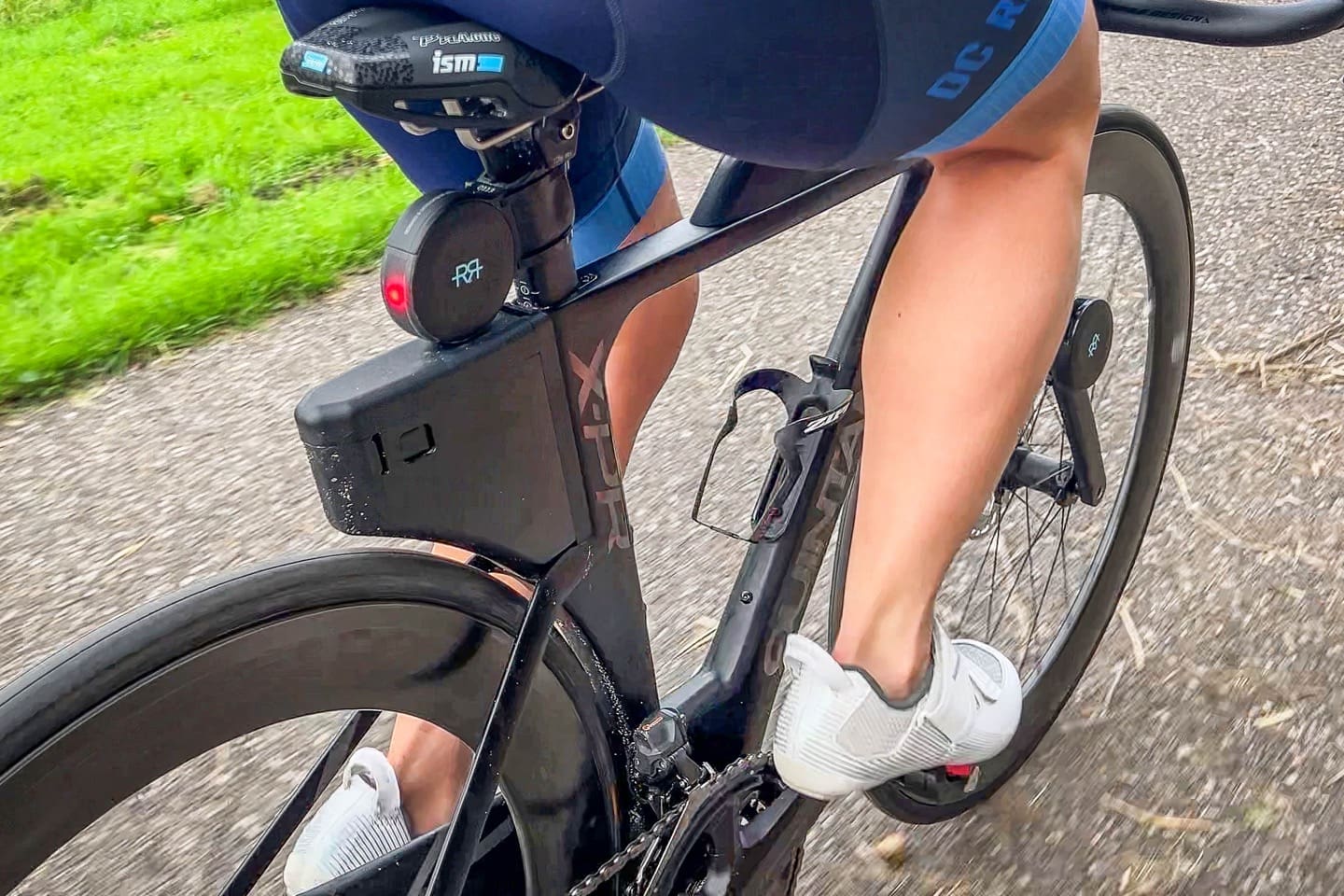
Now, let’s just dig a little bit deeper on the components and how they work together. Essentially each pod has four types of communication components within it:
A) GPS
B) Bluetooth
C) UltraWideBand (UWB)
D) LoRa
Each of those components largely complements each other, but is used in different stages. To begin, LoRa is used as the long-range communications mechanism, for those transmissions upwards of 10KM between devices and to refs. Of course, the system is a mesh network, so it’s pretty unlikely you’d have any competitor on a triathlon course more than 10KM away from any other competitor. Nonetheless, the capability is there. Note, there is no cellular connectivity within it (e.g., no SIM cards).

Next, there’s GPS. GPS is the initial and primary location mechanism for general placement of the athlete. Meaning, it’s using GPS to get a rough idea of where the athlete is, but that’s not actually what’s used in the draft zone validation. GPS isn’t quite accurate enough at all times to be used there (such as in forested areas or cities/etc…). Sure, GPS can be within a meter or so, but again, that’s not good enough in this context.
Thus, GPS is used to identify where an athlete is generally, and the direction of travel (so it’s not triggering on athletes going a different direction). Then, once an athlete gets within about 30 meters of another athlete, Bluetooth distance ranging kicks in, to start narrowing that down. As the athlete gets closer and closer to the athlete they are passing, it transitions to UWB, which is the final technology component that’s ultra precision.
Race Ranger says the system is within 10cm of precision, once within that 30-meter range. And measurements update at 10-times per second.
In addition to the outlined communications tech, the unit also is wirelessly charged, has a battery life longer than any Iron-distance competitor would need, and has accelerometers and NFC for potential future use. The device weight is about 85g.
The company notes that the hardware you see here is really their first gen variant. Future versions they are working on sound like they’ll be considerably smaller.
Going Forward:
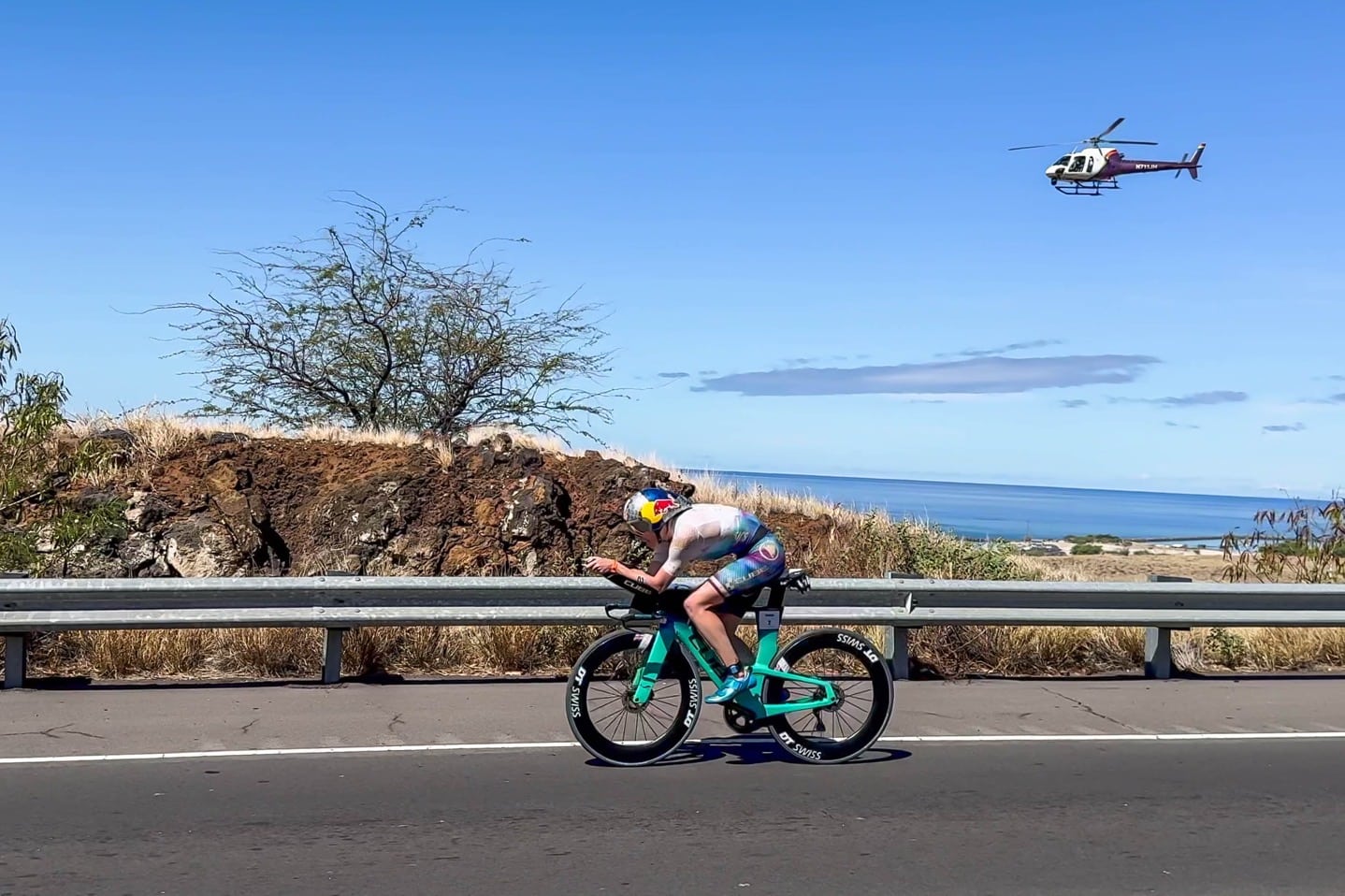
What is probably the most fascinating element of this system is actually some of the historical data being tracked. Both historical to the entirety of the race, but potentially to the athlete long term. In today’s races, the refs have a tablet which shows not just the nearby athletes and current drafting state, but also a metric that lists how much illegal draft time each competitor has (meaning time beyond the allowed passing time for each pass). This is currently prioritized on the refs tablets to allow them to sort by the worst offenders, and their current position/location on the course.
This means that a ref can now go find and visit those athletes who are potentially in need of some babysitting. Again, this doesn’t mean those athletes are getting automatic penalties. Instead, it’s delivering on the wish that countless triathletes have always asked for when seeing serial drafters: A ref to just hang out with that person, and finally catch them in the act.
Looking at Ironman Florida this weekend, the 75 pros racing are all being equipped with the system. However, the refs will not be using the tablets on-moto this weekend. Instead, they’ll be watching the same light-system that athletes do, side-by-side with them.
However, this race will have a new feature: Downloading all of that data. Race Ranger’s James Elvery says “We should be able to give [Ironman] information like which athlete drafted the most, who they drafted off and for how long, how many times each athlete yo-yo’d (entered a draft zone then backed out) etc”.
He reiterated again that no penalties will be handed out retroactively. Instead, that data could form the basis of a ‘drafting passport’ of sorts, which gives future race refs athletes to perhaps spend more time on. Those are all conversations that’ll be happening with Ironman following this race, likely with input from pro athletes as well.
But, those are all things that’ll be worked out in the future. Instead, for both the races it’s been used in already, and now this weekend’s race, the immediate benefits for pros is clarity on exactly where the draft zone starts and ends, and how to avoid a penalty. It’ll be fascinating to see how quickly this technology gets adopted, as more big-name race organizers have started dipping their toe into the water.
With that – thanks for reading!
FOUND THIS POST USEFUL? SUPPORT THE SITE!
Hopefully, you found this post useful. The website is really a labor of love, so please consider becoming a DC RAINMAKER Supporter. This gets you an ad-free experience, and access to our (mostly) bi-monthly behind-the-scenes video series of “Shed Talkin’”.
Support DCRainMaker - Shop on Amazon
Otherwise, perhaps consider using the below link if shopping on Amazon. As an Amazon Associate, I earn from qualifying purchases. It doesn’t cost you anything extra, but your purchases help support this website a lot. It could simply be buying toilet paper, or this pizza oven we use and love.

















As someone who is very colour blind are the colours of the lights the only thing you have to go on?
Aside from not being in the draft zone, yes, there’s no chirps at the moment in a default config. That said, given the system does chirp for penalties, perhaps there’s also a chirping mode for colour-blind athletes. I’ll ask.
I’ve been involved with some of the testing of these units (University of Canterbury, NZ) – and this has been a consideration in the design. I have a red/green colour deficiency – the most common type of colour “blindness”. For those with red/green deficiency, the blue light is very clearly distinguishable (and for me, so is the orange/red). Also – the lights ‘flash’ to indicate various conditions (e.g. being within the draft zone for too long). Furthermore, it is actually a line of LEDs, and – like traffic lights -the LEDs are in different positions. It is rather subtle, and possibly not something an occasional user would pick up on, but a colour blind pro using it week in week out could probably learn to distinguish by position, particularly during LED transitions.
(link to canterbury.ac.nz)
Thanks for the insight. I’m red/green and but my biggest problem in real use is the red/orange/yellow/green LEDs.
Things like network switches are a nightmare for me!
Wonder if a colour blind mode could be used where someone is registered as colour blind and the device in front detects that and can do something more prominent.
Wouldn’t it be better to use one of those CDA sensors to see if the rider is actually getting an aerodynamic benefit rather than just a set distance? I could see if measuring if your CDA lowered, but the person ahead of you didn’t lower, it meant you were drafting, but if both of you lowered it means you’ve got a tail wind, etc.
In some ways, the best answer to that question is to look at the aerosensor industry as a whole, and how many have successfully made products. Or even, reasonably priced products.
Aero sensors are incredibly tricky business, and most require some moderate level of calibration – something that couldn’t be done in 15-30 seconds in transition area at 4AM (or even the day before). It usually requires pedaling an out/back section for some kilometers to calibrate, along with a bunch of moon phases cross-coordinated with tidal patterns and gifts to the gods of the wind.
:-/
Are they going to publish the “drafting passport data” – whilst you might not catch people in the act, being named and shamed (with data to back it up) would be a pretty quick way to stamp it out.
One question – does the RR pod record the distance data in the file – so could it say that Joe spent 90 seconds in Steve’s drafting zone and 55 seconds of that was spent at a distance of less than 5m? As it can be calibrated for distance, I assume that data conceptually exists, but do they collect it? Because as you say, accidentally rolling into someone’s zone and going 11.5m for 5s is very different to sitting at 8m for 45 seconds – ones a whoopsie – one’s taking the piss.
The other interesting observation is that I have heard reports that some pros are using Garmin Varia’s “for safety” but in fact, they get the benefit of the radar to ID fast approaching vehicles, i.e. draft busters, from however far out!
On a different note, whilst I would love this in the age group field as well, I don’t see that happening for a while. Whilst many people claim to want draft free races, the number of paying customers that are willing to cheat for a fast time, KQ, or to pander to their ego, is sufficiently high that race organisers will continue not to penalise even blatant cheats even with the data to back it up.
I don’t think anyone has gotten far into the discussions of exactly how to publish that data yet, but I’d be very surprised if anyone was going to publish that data publically.
As far as the different portions in relation to time/distance, yes, they do capture that data. That’s specifically what they’re looking at seeing post-race, what might be interesting to Ironman (or other race organizers).
Personally, I think that data is really most useful privately used by IM/PTO/Challenge/etc… If the end-goal is reducing drafting by certain offenders, then having a list of known offenders is super easy to monitor. Many of these top-end pro races have tons of official motos (arguably, too many) – so effectively assigning one to a given competitor for long periods of time would seemingly send a clear message. Both to that competitor, but also likely to all the other pros around them, who would easily see the forever-buddy official and know why.
Now, down the road in 2-3 years once the system is considered widely trusted by pros, then maybe there’s more appetite for giving out penalties for the absolute worst offenders (e.g. total illegal time well beyond the norms). But I think that’s got lots of hurdles.
I’d think that one of the better applications is simply PR. Everytime a big pro gets a penalty at a WC type event which takes them out of contention, there’s always a discussion about merit of the penalties or the place of penalties. Now that race can just show the data: Athlete x spend y seconds in the draft zone and then backed out. Done, no subjective polemics.
This will be a mess if implemented because of the amount of people that are racing. The problem is not drafting but how many people are racing. (That is what encourage drafting)
What about offset left or right? On closed courses, it seems like the riders would have ample opportunity to ride in a kind of negative echelon – meaning behind and offset enough to get no draft benefit.
With the accuracy of the system and some testing, maybe they can justify reducing the keep out zone. I imagine the current rules are based on the ability to enforce it and is not purely scientific.
One thing I worry about if this is expanded to age groupers is simply mounting these on our bikes. In my case specifically I have a rear hydration system behind my saddle as well as a saddlebag that mounts vertically along the seatpost for my emergency tools and supplies. There really is no room for something else on the seatpost and I’m not the only one in long course triathlon that has this sort of setup. Being a tri bike the frame is fairly compact so it’s not like I have a bunch of other places I can carry things on the bike. Plus with age groupers you have a wide variety of bikes (and seatposts) so hopefully they’ll have multiple mounting options if this is ever expanded to age groupers. Maybe an alternative way to mount it on the seat stay similar to how the front pod is mounted on the fork.
Glad to hear there’s no plan for automatic penalties though. That was a concern of mine when I first heard of this system but as long as referees are still able to make judgement calls it could be pretty useful.
Ray,
Any thought of having a “distance to next competitor” field to display on the head unit? (at least while you are within 30m of them).
That’d be super cool. And technologically pretty easy to pull off, via something like CIQ data fields (at least on Garmin). They’d have to have some sort of pairing/confirmation process though, which might be a bit messy.
But I could see how in a few years it could be something that perhaps software could account for (for example, in a way similar to how Garmin made a specific sport mode for Adventure Racing (link to dcrainmaker.com).
RR has been confirmed for next year’s Challenge Roth as well.
I think you nailed it in the last section. The biggest benefit is for the pros knowing whether or not they entered the draft zone. I am quite confident that most of them do not want to cheat. But simply due to the fact that marginal gains nowadays draw the line between a podium and place 15, voluntarily adding three extra meters for being on the save side is simply no option.
Still, this is obviously not going to fix each and every discussion about drafting penalties. Simply imagine the case when you enter the draft zone of the rider in front of you, but he at the sime point in time starts overtaking the guy in front of him. Is it your fault that you fail overtaking him in time? Is he blocking you? Maybe the road will get to narrow for three athletes next to each other? Sometimes you have to stop an attempt to overtake just for safety reasons…
Where it really would be helpful, is using them in the AG-races. I would even pay for it, if they would use it. I guess, that 60-80% (depends on the race) of the AG-results in IRONMAN are made by drafting. And drafting is form me the same as doping. The only difference is the availability/chance to do it. But the reason behind is the same. Cheating!
would be good to have imaginable center line visualizer.
LS ftw!
If the system made it guaranteed that not following drafting rules would result in a penalty, people could aggressively game the system to knock out competitors. Just pass someone and immediately slow down so they don’t fall out of the draft zone in time. Wouldn’t that work?
I think that’s why at this point there’s not a lot of interest in automated penalties. That said, the cool part of tech is that with so many sensors in there, picking up this sort of slowing down after passing is trivial.
Sure, but since it isn’t illegal to do this (i.e., as long as one is not blocking), I don’t see what detection has to do with it. There would need to be a rule change. And to detect it, the system would need to monitor not only distances between bikes, but continuously monitor speeds.
The best artcile on @raceranger I have ever read. One rule is not clear: once the athletes enter the draft zone, do they have to go forward and complete the pass OR can they back off? And how many secondes do they have to complete the pass? Thanks in advance.
In terms of triathlon rules, once an athlete enters the draft zone, the only legal way is forward within the allotted time period. Meaning, you can’t keep going in/out, you have to complete the pass, else, it’s considered drafting.
Now, there’s a secondary rule around blocking – whereby if the person tries to block your path from passing. But as soon as the front wheel passes by the cyclist you’re overtaking, they have to drop back out of the draft zone.
The exact time amount varies by race (primarily race org), but for Ironman it’s 25 seconds.
Thanks, but I know that. I have read your entire article. What you are saying here is what we were used to with Ironman. It doesn’t say that it is NOW the rule in Florida for ex. I am saying that because in past PTO events, athletes were allowed to back off when hitting the red light, which I don’t think should be allowed. Also at PTO events, athletes didn’t have a precise number of seconds to pass (if I am correct). It was a bit “cloudy” . If that is, in fact the rule for today’s race and future ones, fantastic!
Perhaps also something for Adam Hansen. He stated to build something himself for the distance of moto’s in pro-cycling races.
So the brake-away doesn’t have a draft benefit from those moto’s